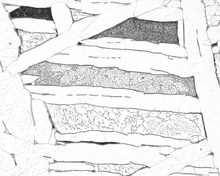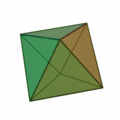Widmanstätten pattern

Widmanstätten patterns, also called Thomson structures, are figures of long nickel-iron crystals, found in the octahedrite iron meteorites and some pallasites. They consist of a fine interleaving of kamacite and taenite bands or ribbons called lamellae. Commonly, in gaps between the lamellae, a fine-grained mixture of kamacite and taenite called plessite can be found. Widmanstätten patterns describe features in modern steels,[1] titanium and zirconium alloys.
Discovery

In 1808, these figures were named after Count Alois von Beckh Widmanstätten, the director of the Imperial Porcelain works in Vienna. While flame heating iron meteorites,[2] Widmanstätten noticed color and lustre zone differentiation as the various iron alloys oxidized at different rates. He did not publish his findings, claiming them only via oral communication with his colleagues. The discovery was acknowledged by Carl von Schreibers, director of the Vienna Mineral and Zoology Cabinet, who named the structure after Widmanstätten.[3]
However, it is now believed that full credit for the discovery should actually be assigned to G. Thomson as he published the same findings four years earlier.[3][4][5]
Working in Naples in 1804, Thomson treated a Krasnojarsk meteorite with nitric acid in an effort to remove the dull patina caused by oxidation. Shortly after the acid made contact with the metal, strange figures appeared on the surface, which he detailed as described above. Civil wars and political instability in southern Italy made it difficult for Thomson to maintain contact with his colleagues in England. This was demonstrated in his loss of important correspondence when its carrier was murdered.[4] As a result, in 1804, his findings were only published in French in the Bibliothèque Britannique.[3][4][6] At the beginning of 1806, Napoleon invaded the Kingdom of Naples and Thomson was forced to flee to Sicily[4] and in November of that year, he died in Palermo at the age of 46. In 1808, Thomson's work was again published posthumously in Italian (translated from the original English manuscript) in Atti dell'Accademia Delle Scienze di Siena.[7] The Napoleonic wars obstructed Thomson's contacts with the scientific community and his peregrinations across Europe, in addition to his early death, obscured his contributions for many years.
Name
The most common names for these figures are Widmanstätten pattern and Widmanstätten structure, however there are some spelling variations:
- Widmanstetter (proposed by Frederick C. Leonard)[8]
- Widmannstätten (used for example for the Widmannstätten lunar crater)
- Widmanstatten (Anglicized)
Moreover, due the discover priority of G. Thomson, several authors suggested to call these figures Thomson structure or Thomson-Widmanstätten structure.[3][4][5]
Lamellae formation mechanism


Iron and nickel form homogeneous alloys at temperatures below the melting point; these alloys are taenite. At temperatures below 900 to 600 °C (depending on the Ni content), two alloys with different nickel content are stable: kamacite with lower Ni-content (5 to 15% Ni) and taenite with high Ni (up to 50%). Octahedrite meteorites have a nickel content intermediate between the norm for kamacite and taenite; this leads under slow cooling conditions to the precipitation of kamacite and growth of kamacite plates along certain crystallographic planes in the taenite crystal lattice.
The formation of Ni-poor kamacite proceeds by diffusion of Ni in the solid alloy at temperatures between 700 and 450 °C, and can only take place during very slow cooling, about 100 to 10,000 °C/Myr, with total cooling times of 10 Myr or less.[9] This explains why this structure cannot be reproduced in the laboratory.
The crystalline patterns become visible when the meteorites are cut, polished, and acid etched, because taenite is more resistant to the acid. In the picture shown, the broad white bars are kamacite (dimensions in the mm-range), and the thin line-like ribbons are taenite. The dark mottled areas are called plessite.

The dimension of kamacite lamellae ranges from coarsest to finest (upon their size) as the nickel content increases. This classification is called structural classification.
Use
Since nickel-iron crystals grow to lengths of some centimetres only when the solid metal cools down at an exceptionally slow rate (over several million years), the presence of these patterns is the proof of the extraterrestrial origin of the material and can be used to easily determine if a piece of iron comes from a meteorite.
Preparation
The methods used to reveal the Widmanstätten pattern on iron meteorites vary. Most commonly, the slice is ground and polished, cleaned, etched with a chemical such as nitric acid or ferric chloride, washed, and dried.[10][11]
Shape and orientation
Cutting the meteorite along different planes affects the shape and direction of Widmanstätten figures because kamacite lamellae in octahedrites are precisely arranged. Octahedrites derive their name from the crystal structure paralleling an octahedron. Opposite faces are parallel so, although an octahedron has 8 faces, there are only 4 sets of kamacite plates. Iron and nickel-iron form crystals with an external octahedral structure only very rarely, but these orientations are still plainly detectable crystallographically without the external habit. Cutting an octahedrite meteorite along different planes (or any other material with octahedral symmetry, which is a sub-class of cubic symmetry) will result in one of these cases:
- perpendicular cut to one of the three (cubic) axes: two sets of bands at right angles each other
- parallel cut to one of the octahedron faces (cutting all 3 cubic axes at the same distance from the crystallographic centre) : three sets of bands running at 60° angles each other
- any other angle: four sets of bands with different angles of intersection


Structures in non-meteoritic materials
The term "Widmanstätten structure" is also used on non-meteoritic material to indicate a structure with a geometrical pattern resulting from the formation of a new phase along certain crystallographic planes of the parent phase, such as the basketweave structure in some zirconium alloys. The Widmanstatten structures form due to the growth of new phases within the grain boundaries of the parent metals, generally increasing the hardness and brittleness of the metal. The structures form due to the precipitation of a single crystal-phase into two separate phases. In this way, the Widmanstatten transformation differs from other transformations, such as a martensite or ferrite transformation. The structures form at very precise angles, which may vary depending on the arrangement of the crystal lattices. These are usually very small structures that must be viewed through a microscope, because a very long cooling rate is generally needed to produce structures visible to the naked eye. However, they usually have a great and often an undesirable effect on the properties of the alloy.[12]
Widmanstatten structures tend to form within a certain temperature range, growing larger over time. In carbon steel, for example, Widmanstatten structures form during tempering if the steel is held within a range around 500 °F (260 °C) for long periods of time. These structures form as needle or plate-like growths of cementite within the crystal boundaries of the martensite. This increases the brittleness of the steel in a way that can only be relieved by recrystallizing. Widmanstatten structures made from ferrite sometimes occur in carbon steel, if the carbon content is below but near the eutectoid composition (~ 0.8% carbon). This occurs as long needles of ferrite within the pearlite.[12]
Widmanstatten structures form in many other metals as well. They will form in brass, especially if the alloy has a very high zinc content, becoming needles of zinc in the copper matrix. The needles will usually form when the brass cools from the recrystallization temperature, and will become very coarse if the brass is annealed to 1,112 °F (600 °C) for long periods of time.[12] Telluric iron, which is an iron-nickel alloy very similar to meteorites, also displays very coarse Widmanstatten structures. Telluric iron is metallic iron, rather than an ore (in which iron is usually found), and it originated from the Earth rather than from space. Telluric iron is an extremely rare metal, found only in a few places in the world. Like meteorites, the very coarse Widmanstatten structures most likely develop through very slow cooling, except that the cooling occurred in the Earth's mantle and crust rather than in the vacuum of space.[13]
However, the appearance, the composition and the formation process of these terrestrial Widmanstatten structures are different from the characteristic structure of iron meteorites.
Pattern-welded steels such as Damascus steel also bear patterns, but they are easily discernible from any Widmanstätten pattern.
 Widmanstätten pattern observed in Zircaloy 4, βZr grain boundaries are still visible even though βZr has been transformed to Widmanstätten.
Widmanstätten pattern observed in Zircaloy 4, βZr grain boundaries are still visible even though βZr has been transformed to Widmanstätten. Micrograph of the previous probe
Micrograph of the previous probe
See also
Notes
- ↑ DOMINIC PHELAN and RIAN DIPPENAAR: Widmanstätten Ferrite Plate Formation in Low-Carbon Steels, METALLURGICAL AND MATERIALS TRANSACTIONS A, VOLUME 35A, DECEMBER 2004—3701
- ↑ O. Richard Norton. Rocks from Space: Meteorites and Meteorite Hunters. Mountain Press Pub. (1998) ISBN 0-87842-373-7
- 1 2 3 4 John G. Burke. Cosmic Debris: Meteorites in History. University of California Press, 1986. ISBN 0-520-05651-5
- 1 2 3 4 5 Gian Battista Vai, W. Glen E. Caldwell. The origins of geology in Italy. Geological Society of America, 2006, ISBN 0-8137-2411-2
- 1 2 O. Richard Norton. The Cambridge Encyclopedia of meteorites. Cambridge, Cambridge University Press, 2002. ISBN 0-521-62143-7.
- ↑ F. A. Paneth. The discovery and earliest reproductions of the Widmanstatten figures. Geochimica et Cosmochimica Acta, 1960, 18, pp.176-182
- ↑ G.Thomson. Saggio di G.Thomson sul ferro Malleabile trovato da Pallas in Siberia. Atti dell'Accademia Delle Scienze di Siena, 1808, IX, p. 37.
- ↑ O. Richard Norton, Personal Recollections of Frederick C. Leonard, Meteorite Magazine - Part II
- ↑ J. Goldstein et al. (2009), "Iron meteorites: Crystallization, thermal history, parent bodies, and origin"
- ↑ Harris, Paul; Hartman, Ron; Hartman, James (1 November 2002). "Etching Iron Meteorites". Meteorite Times. Retrieved 14 October 2016.
- ↑ Nininger, H.H. (February 1936). "Directions for the Etching and Preservation of Metallic Meteorites". Proceedings of the Colorado Museum of Natural History. 15 (1): 3–14.
- 1 2 3 Metallography and Microstructure in Ancient and Historic Metals By David A. Scott -- J. Paul Getty Trust 1991 Page 20--21
- ↑ Meteoritic Iron, Telluric Iron and Wrought Iron in Greenland By Vagn Fabritius Buchwald, Gert Mosdal -- Kommissionen for videnskabelige Undersogelse i Gronland 1979 Page 20 on page 20
External links
| Wikimedia Commons has media related to Widmanstätten pattern. |
.jpg)